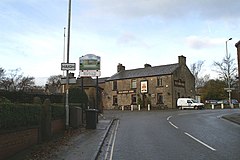Haigh, Wigan
| Haigh | |
|---|---|
 Haigh village |
|
| Haigh shown within Greater Manchester | |
| Population | 594 (2001) |
| OS grid reference | SD605090 |
| Metropolitan borough | |
| Metropolitan county | |
| Region | |
| Country | England |
| Sovereign state | United Kingdom |
| Post town | WIGAN |
| Postcode district | WN1 / WN2 |
| Dialling code | 01257 / 01942 |
| Police | Greater Manchester |
| Fire | Greater Manchester |
| Ambulance | North West |
| EU Parliament | North West England |
| UK Parliament | |
Haigh (/heɪ/) is a village and civil parish of the Metropolitan Borough of Wigan in Greater Manchester, England.Historically a part of Lancashire, it is located next to the village of Aspull. The western boundary is the River Douglas which separates the township from Wigan. To the north a small brook running into the Douglas divides it from Blackrod. At the 2001 census it had a population of 594.
Haigh is derived from the Old English haga, a hedge and means "the enclosure". The township was variously recorded as Hage in 1193, Hagh in 1298, and Haghe, Ha and Haw in the 16th century.
Between 1220 and 1230 the manor was part of the Marsey fee. Hugh de Haigh, probably Hugh le Norreys paid 3 marks in 1193–4 for having the king's good will. Richard de Orrell granted land in Haigh to Cockersand Abbey in 1220. In 1282 Hugh le Norreys was lord of Haigh. His daughter Mabel married William Bradshagh and in 1298 they inherited the manors of Haigh and Blackrod from Mabel's father. Bradshagh took part in Adam Banastre's rebellion in 1315 for which he was outlawed and by 1317 his manors were confiscated by the crown and granted to Peter de Limesey. William was presumed dead and Mabel remarried, but he returned in 1324 and killed Mabel's new husband. Sir William was killed at Winwick in August 1333. As penance, a legend states that Mabel walked barefoot from Wigan to Haigh every week for the rest of her life. The legend was made into a novel by Sir Walter Scott, and is remembered by Mab's Cross in Wigan Lane. In 1336 and 1337 Mabel Bradshaigh arranged for the succession of the manors to her husband's nephews; Haigh to William, son of John de Bradshagh, and Blackrod to Roger, son of Richard. In 1338 she founded a chantry in Wigan Church. She held the manor until 1346.
...
Wikipedia

